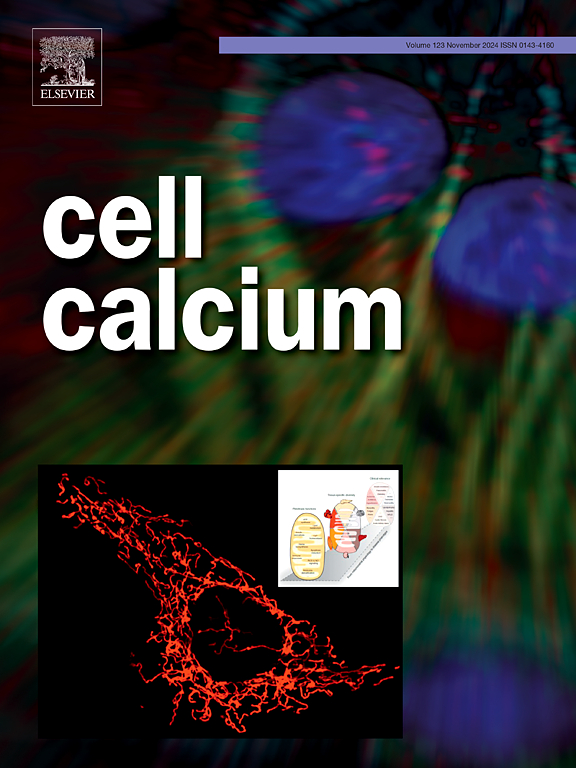钙作为线粒体-核网络驱动的逆行信号的关键决定因素
IF 4.3
2区 生物学
Q2 CELL BIOLOGY
引用次数: 0
摘要
线粒体是调节多种细胞功能的强大信号细胞器。驱动线粒体信号传导的关键机制之一是细胞器间串扰。线粒体主要通过钙(Ca2+)、活性氧(ROS)和脂质在细胞器膜上的交换与其他细胞器进行通信。线粒体有自己的基因组,但大部分线粒体蛋白是由核基因组编码的。因此,线粒体的一些功能是由细胞核通过顺行信号控制的。然而,线粒体在驱动核基因组编码基因表达中的作用近年来引起了人们的关注。最近的独立研究小组已经证明了线粒体Ca2+信号在刺激核基因表达中的关键作用。这些研究报道了通过沉默线粒体Ca2+单转运蛋白(MCU)抑制线粒体Ca2+摄取导致细胞质中Ca2+振荡。胞浆内Ca2+的升高导致Ca2+敏感转录因子如nfat和NF-κB的激活。这些转录因子因此诱导其靶基因在核基因组中的表达。重要的是要强调,这些小组使用不同的细胞类型,并优雅地呈现了一种在不同系统中保守的现象。值得注意的是,线粒体Ca2+信号介导的转录调节控制着多种细胞功能,包括b细胞活化、黑色素生成和衰老相关炎症。未来对这一信号模块的研究将有助于更好地理解人类病理生理学中的这一轴,并可能导致新的治疗策略的发展。本文章由计算机程序翻译,如有差异,请以英文原文为准。
Calcium acts as a critical determinant of mitochondria-nuclear networking driven retrograde signaling
Mitochondria are robust signaling organelle that regulate a variety of cellular functions. One of the key mechanisms that drive mitochondrial signaling is inter-organelle crosstalk. Mitochondria communicates with other organelles primarily via exchange of calcium (Ca2+), reactive oxygen species (ROS) and lipids across organelle membranes. Mitochondria has its own genome but a majority of mitochondrial proteins are encoded by nuclear genome. Therefore, several mitochondrial functions are controlled by nucleus via anterograde signaling. However, the role of mitochondria in driving expression of genes encoded by nuclear genome has recently gained attention. Recent studies from independent groups have demonstrated a critical role for mitochondrial Ca2+signaling in stimulating nuclear gene expression. These studies report that inhibition of mitochondrial Ca2+uptake through silencing of Mitochondrial Ca2+Uniporter (MCU) leads to Ca2+oscillations in the cytosol. The rise in cytosolic Ca2+ results in activation of Ca2+ sensitive transcription factors such as NFATs and NF-B. These transcription factors consequently induce expression of their target genes in the nuclear genome. It is important to highlight that these groups used different cell types and elegantly presented a phenomenon that is conserved across various systems. Notably, mitochondrial Ca2+ signaling mediated transcriptional regulation controls diverse cellular functions ranging from B-cell activation, melanogenesis and aging associated inflammation. Future studies on this signaling module would result in better understanding of this axis in human pathophysiology and could lead to development of novel therapeutic strategies.
求助全文
通过发布文献求助,成功后即可免费获取论文全文。
去求助
来源期刊

Cell calcium
生物-细胞生物学
CiteScore
8.70
自引率
5.00%
发文量
115
审稿时长
35 days
期刊介绍:
Cell Calcium covers the field of calcium metabolism and signalling in living systems, from aspects including inorganic chemistry, physiology, molecular biology and pathology. Topic themes include:
Roles of calcium in regulating cellular events such as apoptosis, necrosis and organelle remodelling
Influence of calcium regulation in affecting health and disease outcomes
 求助内容:
求助内容: 应助结果提醒方式:
应助结果提醒方式:


